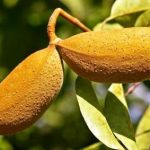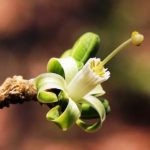TREE LIFE
SEPTEMBER 1994
Gill Masterson who is a well loved and special member of our society turned 90 on Saturday 3rd September. CONGRATULATIONS GILL, AND WE ALL WISH YOU A VERY HAPPY DAY.
MASHONALAND CALENDAR
Tuesday 6th September. Botanic Garden Walk at 4.45 for 5 p.m. There will be a security guard at the public car park and this is where we will meet Tom. If you have a specific subject which you would like Tom to concentrate on please let me know.
Sunday 18th September. A little closer to Harare this month when we revisit the Clark family farm, Gilnockie, in the Arcturus District. Our last visit was 12 years ago, and references to the field card promises an interesting day, with riverine, woodland and at this time of year the Msasa flush. Meeting time 9.30 a.m.
Saturday 24th September. We meet at the Arboretum on the shores of Lake Chivero for the start of Mark’s Botanic Interest Walk. Time – 3 p.m. as usual. Bring some cash in case we decide to venture further.
Friday 23rd, Saturday 24th and Sunday 25th September
National Garden Expo – 1994 at Ruwa Country Club. A public display of different gardening styles, com¬bined with commercial stands. This event will cover all things pertaining to both private and public gardens. The purpose is Entertainment, Education and Environmental issues with demonstrations, lectures and displays. Facilities include a parking area patrolled by security guards, an English Tea Garden, a Dutch Beer Garden, a children’s crèche and St. John Ambulance personnel will be present.
Tuesday 4th October. Botanic Garden Walk. Flowering time!
MATABELELAND CALENDAR
Sunday 4th September. To Hendrik’s Pass in the Western Matopos. Rendezvous and departure from Girls’ College at the usual time – 8.30 a.m.
Friday 30th September. “Tree Planting Workshop” by the Rotary Club of Bulawayo at Old Falls Road Nursery at 2 p.m. Demonstration by Mr. D. Erwee and Mr. Mlapisani.
BOTANIC GARDEN WALK: 6 AUGUST 1994
With the planned visit to Penhalonga starting on the 10 August, we asked Tom to show us trees we might see there. Writing this account after the trip to Penhalonga, during which we went to the Vumba and Murahwa’s Hill in Mutare, I can report how useful this revision was in the field. The following is just a selection of some of the trees Tom showed us together with a comment as to whether we eventually did see them on our Eastern Districts trip or not!
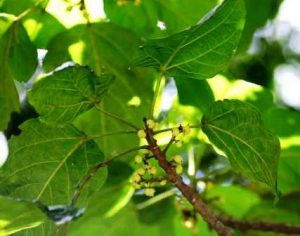
Macaranga mellifera. Photo: Bart Wursten. Source: Flora of Zimbabwe
Firstly, how do you separate Croton sylvaticus and Macaranga mellifera Both are species in the Euphorbiaceae and are quite closely related. This pair has been a problem in the past.
The Croton has the following features: it has a distinctive Croton-like smell in the underbark, the slash is mustard coloured and there are two glands at the apex of the petiole. In addition, the bark has vertical lines with silvery markings along the ridges.
The Macaranga on the other hand has larger leaves than the Croton, there is no distinctive smell, the slash is deep red and the two glands are on the upper surface of the leaf lamina, still near the apex of the petiole, but not on it. The bark is smooth and more or less unlined.
In the event we saw plenty of Macaranga (but no Croton) in the Vumba.
Another species we looked at was Trilepisium madagascariense, which is a member of the fig family and like figs, it produces copious milk. It has shiny dark green leaves with prominent acuminate tips. Not a species we often see. In the event, Ian McCausland had found it in the Vumba.
Cola greenwayi has a simple leaf with a very prominent pulvinus (appearing as a bulge) where the petiole joins the leaf blade. The pulvinus is a complex mechanism which allows trees growing in the understorey of forests where the lack of light is a problem to orientate the leaf so as to capture the available light. This species was eventually seen by at least one group on the edge of the Bunga Forest in the Vumba.
In the Gardens, we examined, in passing, the strongly aromatic Camphor Tree (Cinnamomum camphora) with its gland-dotted leaves. This species belongs to the Lauraceae; it comes from the Far East and is an alien in Zimbabwe. Somewhat to my surprise, it turned out to be frequent and apparently well naturalised, along with quite a number of other exotics, in the woodland on the hillside above La Rochelle.
Finally, I would like to mention three other species which were previewed by Tom and which we saw on our trip. One was Bersama abyssinica with its distinctive pinnate leaves which have winged rhachis. This we saw frequently near Penhalonga and in the Vumba.
Xymalos monospora turned out to be common where we stopped in the Vumba. It has green twigs and relatively large leaves with a few large serrations near the apex and a slightly quitted feel.
Pittosporum viridiflorum which Tom mentioned was common in regenerating forest, did indeed turn out to be just that, especially on the hillsides above La Rochelle where it was sometimes covered in clusters of yellow berries.
Once again, we thank Tom for our great good fortune in having access to the wonderful collections in the Botanic Gardens.
-MARK HYDE
LA ROCHELLE 11 AUGUST 1994
One of the most significant developments at La Rochelle has been the Braille Trail through the Dell and ending at the Nature trail above the gardens.
Imagine for a few moments, a world without sight and only your senses to guide your steps. And so it was a strange sensation to walk along a short distance of the trail with our eyes closed and allowing the feel of the cord next to the path to control our movements. At a single knot a notice ahead described the surroundings in both Braille and large print and also an encouragement to feel the plants nearby – a pinch of Rosemary (Rosmarinus officinalis) or the spiny trunk of an Erythrina lysistemon. Meeting two knots indicates time to change sides of the path and three knots – end of the rope! At the end of some fifteen stops the last notice suggested stopping for a while in the shade of a large Ficus sur (frosted) and listen to the bird calls and the sound of the wind scurrying about in the tree tops. Having ducked out of the main party meandering about in the nature trail, the sound of their progress wafted down to us below.
As Penhalonga is well known for its mighty Eucalyptus trees we headed off later in the day for the site of these monsters, stopping en route at the Nurses Memorial at Old Umtali. The path to the gardens around the memorial was accessed via a large iron-gate with the date 1853/1953 forged into the frame. Three venerable Ficus lutea cast their shadows over the garden which also contained an interesting Aloe hybrid – Aloe cameronii x ?
Unfortunately the number of logging trails prevented us from finding the grove of the giants but we found a smaller grove near a stream and marvelled at the pinky-grey trunks stretching skywards. In the valley beyond Mountain Home farmhouse monster Eucalypts stood in a cleared area and Linda estimated the height to be ±82 metres. Four able bodied males managed to link hands and circle the bole of the tree – much to the amazement of the local populace gathered nearby.
The choking dust churned up by the convoy of vehicles was really something and with the sun dipping behind the hills we bade farewell to the rapidly darkening forests.
-Andy Macnaughtan
MURAHWA’S HILL: FRIDAY 12 AUGUST
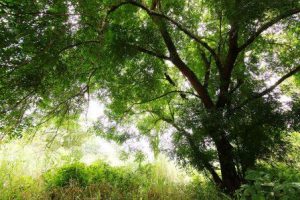
Zanha golungensis. Photo: Bart Wursten. Source: Flora of Zimbabwe
Although our destination was Murahwa’s Hill, a visit to the reputedly largest Zanha golungensis was mooted and accepted. This is situated in Burns Drive in a private garden. The arrival of the convoy of one Landcruiser, three pickup trucks and a Nissan Sentra in a quiet suburban road on a Public Holiday did much to excite the local canine population. Undeterred, Maureen Silva-Jones made our presence known to the occupant of the house and we were given permission to view the truly magnificent specimen in the back garden.
Murahwa’s Hill, a National Trust property is but a short distance down the road, adjacent to the Mutare Agricultural Showgrounds. The lower part of the reserve is a veritable jungle where roads and pathways tunnel their way through a tangle of shrubs, lianas and trees. One is overwhelmed by the richness and diversity of this flora which soon gives way further up slope to a more open forest which in turn in the rocky summit area changes for miombo woodland.
Our task was made a lot easier by having N. Chase’s check list of 102 species (trees and shrubs) to hand. In our two and a half hour visit we only explored a portion of the jungle and the lower reaches of the hillside forests, during which time we identified thirty-one species named on the check list and added seventeen, many of them shrubs and creepers.
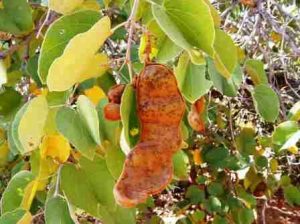
Piliostigma thonningii. Photo: Mark Hyde. Source: Flora of Zimbabwe
In the jungle some of the plants identified were: Piliostigma thonningii, Pterocarpus rotundifolius, Parinari curatellifolia, Combretum molle, Pseudolachnostylis maprouneifolia, Azanza garckeana, Dalbergia melanoxylon, Euphorbia ingens, subjects which one associates with drier environments. And intermingled with these were species from the evergreen forests of the eastern districts such as Bersama abyssinica, Cordia abyssinica, Craibia brevicaudata, Calodendrum capense and Zanha golungensis. Figs were particularly well represented. We saw Ficus sur, Ficus sycomorus, and Ficus thonningii, the latter being of enormous proportions and higher up the hill, an unlisted and unidentified Ficus which only vaguely resembled Ficus ingens. Linking the tree and shrub, layer is a tangle of creepers and lianas such as Toddalia asiatica, Acacia schweinfurthii, Smilax kraussiana, Chaetacme aristata with its distinctive spiny zigzagged branches, Pterolobium stellatum, Rhoicissus tomentosa, Landolphia sp. sporting its golf-ball like fruit, and a large-leafed Strychnos species unidentified with paired tendrils. (Identified that evening as Strychnos lucens – Ed.)
On the edge of the jungle we came across Strychnos usambarensis, in fruit with disappointingly insignificant stipes and a little higher Albizia schimperiana, Khaya nyasica, Zanha golungensis and several of the large unidentified Ficus.
The miombo woodland lay still further up the slope but will have to wait for another visit. Lunch called and we turned down slope to picnic in the jungle and to sip the tea, so kindly made by Maureen in the Teapottus ingens, dispersed so graciously by Andy.
–Ian and Margaret McCausland
MUTARE/BVUMBA: SATURDAY 13 AUGUST
The prospect of a visit to Mozambique was unexpected, intriguing and exciting.
It was on offer which could not be refused – until the morning of our departure when we received reports of minefields and abandoned gold workings with unprotected shafts. A hasty meeting produced a radical change of plan. We would instead, visit the Mutare Museum and forests on the Bvumba. Some were disappointed, others relieved.
For anyone visiting Mutare a stop at the museum is very worthwhile. It caters for a wide range of tastes ranging from ethnography, vintage cars, Rhodesiana to natural history. In addition, it has a very grand aviary – a walk-in affair which not only accommodates birds and full grown trees but observers too. Our next stop was the Bvumba.
For Bulawayo members this was the second visit in less than a week, because prior to moving on to La Rochelle, we had spent, five days in a cottage overlooking the Leopard Rock golf course. Five very frustrating days botanically speaking as almost everything was new and defied keying-out in Coates Palgrave, unless one had the necessary flowers, fruits and leaves to hand. So it was very good to be able to walk with Mark and Maureen who could answer so many of our questions.
At first, everything seems, to be so similar – dark green, drip-tipped, glossy and decussate, but fairly soon the eye becomes more focussed and one begins to pick up the more common plants. At a lush Lay by just beyond Cloudlands and directly below the Cripps property Macaranga mellifera, Aphloia theiformis, Halleria lucida (in flower) and Schefflera umbellifera were the dominant species.
Rising above them were Ekebergia capensis and Syzygium guineense subsp. gerrardii with red-purple leaf tips. And in the understorey of this galleried forest grew Teclea nobilis, Psychotria zombamontana (in fruit), Diospyros whyteana and the usual abundance of lianas, chief of which were Schefflera goetzenii with its interesting rosettes of leaves, Toddalia asiatica, thorny and aromatic, Smilax kraussiana and Piper capense with its sweet smelling leaves. Within the forest itself, the distinctive leaves of Tabernaemontana stapfiana and Cussonia spicata stood out frequently.
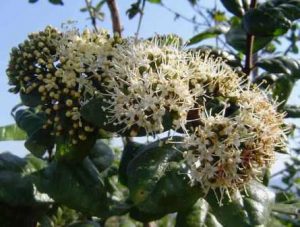
Nuxia congesta. Photo: Bart Wursten. Source: Flora of Zimbabwe
Our second stop at the Bunga picnic site for lunch gave easy access along the firebreak to the forest. On this walk we added to our list of the more easily recognisable plants Dovyalis lucida with its very glossy rotund leaves, Nuxia congesta in flower and sweetly fragrant. Myrianthus holstii, Ficus craterostoma with its very distinctive truncated leaves and, lower down, we found Rawsonia lucida, the shiny Manica pavetta and the hairy Manica pavetta otherwise known as Pavetta umtalensis and Pavetta johnstonii.
The verges and embankments provide habitats for a very distinctive suit of plants which in themselves could give the enthusiast hours of study and fascination.
This was our first botanical visit to the Bvumba and although the list of plants in this article represents only a small fraction of the wonderful floristic diversity of the area, we feel reasonably confident that we could go back with this very basic two dozen and build on it. We hope that other tiros will also find it useful.
-Ian and Margaret McCausland
NYARUPINDA CATCHMENT
The Scene
The sunburned shoulder of the hill
Is hunched against the brilliant sky
In perfect somnolence, until Every sense is lulled thereby.
Until my spellbound heart cries out
That this is Africa for me,
This legacy of winter drought, This bronzed and blue infinity.
For me …who looked for jungle green,
This is the ultimate surprise,
Year after year, this copper sheen
Of dying grass, that never dies.
Bronze Legacy
Olive Robertson
This poem was chosen by Peter Thomson for his article “Chizarira” in Wild Rhodesia Number 2 1973
August’s Palette
Water has been pumped into the Nyarupinda dam it is nearly full, the view along its length to the west is breathtaking in winter when the sun sets over the Mitimitema hills, turning the surface of the water to molten red, green and gold. Along the new shoreline the copper sheen of swamp couch grass glows until all is veiled in twilight.
Recently a search-for-colour-walk was rewarding because the “Table of Flowering and Fruiting Periods” in Common Trees of the Central Watershed Woodlands of Zimbabwe by Robert Drummond reminded me what to look for, thank you Bob. A quick way to find something interesting is to go cautiously around termite mounds where a great variety of plants and especially trees occur, visit a stony hillside, a vlei margin or a perennial stream (becoming rare unfortunately).
Here are some observations. On the paths near the dam there were orange and neutral coloured clumps of fibre which were boluses, the remains of sections of sweet and revoltingly glutinous (to us) Azanza fruit chewed by the local people.
A patch of tall yellow straw-flowers – Helichrysum sp.? – have found their niche in a vlei near the dam. Green buds opening into white flowers belonging to Maerua juncea occurred near the blooms of Ximenia americana, both of these shrubs keep their leaves throughout the year. Nectar-providers in winter are the bunches of red-tipped, blossoms of Tapinanthus which decorate bare branches of Diplorhynchus condylocarpon. Insects and birds are attracted to the Erythrina trees, all the red flowers collected under Erythrina abyssinica had a hole in the folded petals, and Sunbirds pierce the tube of Tecomaria flowers in the garden.
During late afternoon bees were active on Dombeya white inflorescences and then it was time for sunlight to glow through little droplets of the forget-me-not family, Boraginaceae, they shine in the cool light of dawn…unforgettable.
Chilling temperatures in the vleis have had no effect on the dainty flowers and tender young leaves of Rhus longipes.
On the termite mounds pale yellow flowers of Cassia abbreviata are opening as those of Turraea nilotica are finishing but the golden yellow of Senna singueana with its glossy pods is conspicuous for many months.
Mature leaves on shrubby regrowth of Msasa echo the colour of spring foliage which is emerging now, could their vivid russet and crimson have been caused by unusually cold weather? It is difficult to remember the colour of regrowth in previous winters. For the answer to this question it would be delightful to consult Kim Damstra instead of referring (in vain perhaps) to tomes on biology or biochemistry.
On the way to the stony hillside some little plants were nearly missed, the reddish flowers of a stalkless Indigofera and the latex-bearing flowering and fruiting branches no higher than 3cm of Euphorbia decidua about which Alan Percy Lancaster wrote in Excelsa in 1977. No doubt more has been recorded about this succulent plant since then. August and September is when its neutral-tinted tiny blooms and pale green tri-locular fruits appear. Among stunted trees at the top of the quartz outcrop there is a community of African potatoes, their sticky sage-like yellow flowers are on tall dry thin stems. This is one of the edible plants called ‘tsenza’, a species of Plectranthus with tuberous roots, its leaves appear during the rains so they are not easy to identify without the flower unless their habitat is visited regularly. Something resembling these tubers was painted by the rock artists.
August’s Palette would not be realistic without mentioning a few birds. A pair of Cardinal Woodpeckers came here and one of them busied itself pecking at a twig encrusted with Pilostyles, absence of red on the hind-crown of the female was noticed. Large green fruits of Diospyros kirkii caused some frustration for a purple-crested Lourie which came silently to the garden recently, it may return to get ripe fruit. The balance of nature seems to be favouring Black-eyed Bulbuls as well as rats, both are everywhere busily destroying fruit, flowers and vegetables. The bucket and bait eliminated 291 rats. Sometimes a flock of Glossy Starlings come to drink at the birdbath, only rarely does the Spotted Creeper do a rapid check for food on the tree trunks. Near the dam a predator has left the wings, tail, feet and orange beak of a hornbill, although unlikely in this part of Zimbabwe it does appear to be a Bradfield’s Hornbill. Recently we were shown these in Botswana on the floodplain of the Chobe River. As soon as possible the hornbill’s remains will be taken to the Museum to be identified.
My interest in trees began with collecting autumn-tinted leaves; their outlines were filled with watercolours. In preparation for this they were laid flat within square and oblong margins, the latter shape was more successful because the design flowed. To add variety an effort was made to find interesting leaf forms e.g. my favourite Vitex payos and chewed ones, and also those in unusual colours.
The finishing touch was a mist of black dots to fill the largest of the irregular spaces between the leaves, following their edges but half a centimetre distant, the effect was pleasing. A few of these designs deserved a frame. Now many years later, 23 perhaps, there are a much wider range of watercolour paints available to match the dying leaves. E.g. for duiker berry, vermilion and rose carthame which traditionally came from Carthamus tincterius; Faurea speciosa and Combretum adenogonium… alizarin crimson; Flacourtia indica… alizarin crimson with a hint of violet carmine. Regrettably Croton gratissimus was not collected for the designs.
The Civetries. There is no spoor at the two civetries near the vlei, they were abandoned more than a year ago, and dormant tree seedlings mark them. As regards the midden near the garden, the civets habits have changed it comes irregularly and ‘goes’ in four places in the vicinity of the remains of the original spectacular Dung-heap.
-Benedicta Graves
ANDY MACNAUGHTAN CHAIRMAN


